Hi there. This is our fourth and final part of our look back at the pleasures, or otherwise, of driving a slow car in racing games. It takes us up to the end of the 00s or so, roughly in line with the newer games eligible for coverage at FFG.
I’m sure there are plenty of other great examples from more recent racers, and those I’ve missed out or forgotten from other periods. But, for better or worse, I decided to keep the focus on games I have actually played.
So…let’s continue!
Honda CR-X – Juiced (Acclaim, 2005)
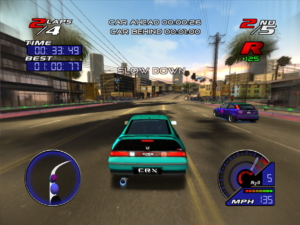 Acclaim’s Juiced arguably got lost between the shinier (and better) NFS games of the time, but – a completely broken auto save system aside – it was still a decent racer.
Acclaim’s Juiced arguably got lost between the shinier (and better) NFS games of the time, but – a completely broken auto save system aside – it was still a decent racer.
Best of all, for our purposes at least, the crappy starter car seemed robust enough to see you through most of the game’s early stages, and with no requirement to make your vehicle more visually appealing, there was something vaguely comical, and satisfying, about defeating hordes of smack talking street-racers armed with a poxy old Honda.
In fact, the usual instinct to abandon your initial vehicle at the earliest opportunity soon became less appealing than dragging out the CR-X’s career for as long as possible.
Fiat Punto – Need for Speed: Most Wanted (Electronic Arts, 2005)
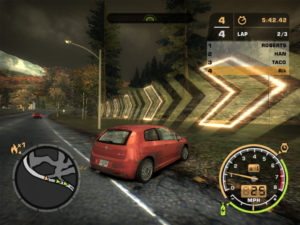 Arguably the high point of the NFS series, Most Wanted nevertheless presented you with a number of vehicles that you’d never pick unless you wanted to give yourself a hard time or derive some comedy value from the experience.
Arguably the high point of the NFS series, Most Wanted nevertheless presented you with a number of vehicles that you’d never pick unless you wanted to give yourself a hard time or derive some comedy value from the experience.
Enter the Fiat Punto, not many people’s idea of a getaway car. During my playthrough, we actually owned a Punto in real life (kindly bequeathed to us by our friend PG upon his departure to the US).
For the first couple of years it was relatively well behaved, but as time went on it became more temperamental: the airbag failed for no reason and couldn’t be fixed; the engine overheated on a dual carriageway on the way to Hemel Hempstead; and the windscreen wipers failed on the motorway (twice).
Anyway, I’m sure it’s just like those Ferraris – they look nice in games and on the telly, but they’re loud and uncomfortable and have terrible fuel economy. So, take it from me – driving a Punto isn’t as glamorous as games like Need for Speed: Most Wanted make it seem.
Mini Cooper – RACE: The WTCC Game (Eidos, 2006)
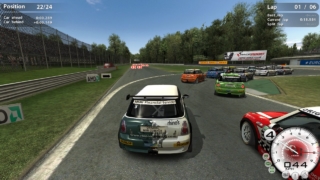 It’s been my experience that arcade track-based racers often give you the option of driving a slower car for laughs but then make the experience of doing so a largely joyless one.
It’s been my experience that arcade track-based racers often give you the option of driving a slower car for laughs but then make the experience of doing so a largely joyless one.
RACE may or may not be the best racing sim (I mean, I liked it) but it did cultivate the sense of precarious danger that you feel would accompany the experience of driving even a modestly powered car around a track at speed. The engine is loud, the car shakes, corners bring a mild feeling of dread, and yet it’s all great fun, to the extent that I could understand why people might go to a race day experience or similar.
Without even starting a full WTCC season, there’s plenty of fun to be had racing around Monza in a Mini.
(Note: screenshot is from RACE 07 as RACE refused to work for some reason).
Audi A3 – Test Drive Unlimited (Atari, 2007)
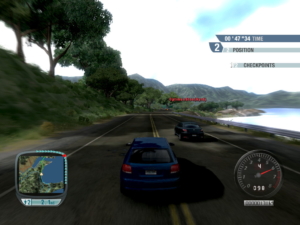 The name Test Drive implies some fun twatting around in cars, so it was criminal really that it took many years of fruitless and low-quality circuit-based racing for the series to return to its roots.
The name Test Drive implies some fun twatting around in cars, so it was criminal really that it took many years of fruitless and low-quality circuit-based racing for the series to return to its roots.
If there’s an arcade racer that allows and encourages you to sample a variety of vehicles, drive them around for fun and beat challenges with them in a non-linear fashion, it’s TDU. Indeed, the early cars are more fun to drive than later challenges involving ludicrous Bugattis and Zondas and the like.
The Audi A3 (pictured here taking on Stoo’s Alfa Romeo, in a rare example of FFG indulging in multiplayer action) is a solid choice to start exploring Hawaii and, er, picking up hitchhikers and models in exchange for clothing vouchers.
As TDU helpfully gives you the full showroom experience, it’s worth pointing out that whatever we might say about crap cars in racing games, even this supposedly bog-standard Audi isn’t the same one that your estate agent might drive, with a list price of $37000 (I don’t know about you, readers, but I certainly don’t imagine ever spending that on a car).
Mazda RX-8 – Juiced 2: Hot Import Nights (THQ, 2008)
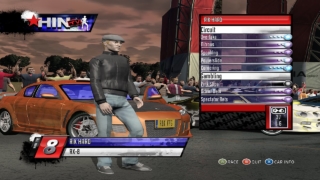 This gaudy sequel delivers plenty of vehicles although not much in the way of distinctive handling models. Still, it does successfully manage to cultivate some sense of ownership through a stats tracking system for each car, tallying up your race wins and losses for each.
This gaudy sequel delivers plenty of vehicles although not much in the way of distinctive handling models. Still, it does successfully manage to cultivate some sense of ownership through a stats tracking system for each car, tallying up your race wins and losses for each.
Such was my attachment to this orange Mazda (pictured here with ludicrous Guy Ritchie avatar) – a potential TigerCar 2 – that I became incensed when I lost it to a rival and engaged in a costly and ultimately fruitless battle to win it back.
If, like myself, you’re a veteran of silly arcade racers but remain ignorant of real-life car performance issues, you might also be puzzled by the way the same cars seem to be ranked differently in different racing games. In Juiced 2, the RX-8 is a lowly machine, while in, say, Need for Speed: Underground 2, it’s near the top. Next time: some kind of graph comparing them all in painstaking detail.



 Posts
Posts